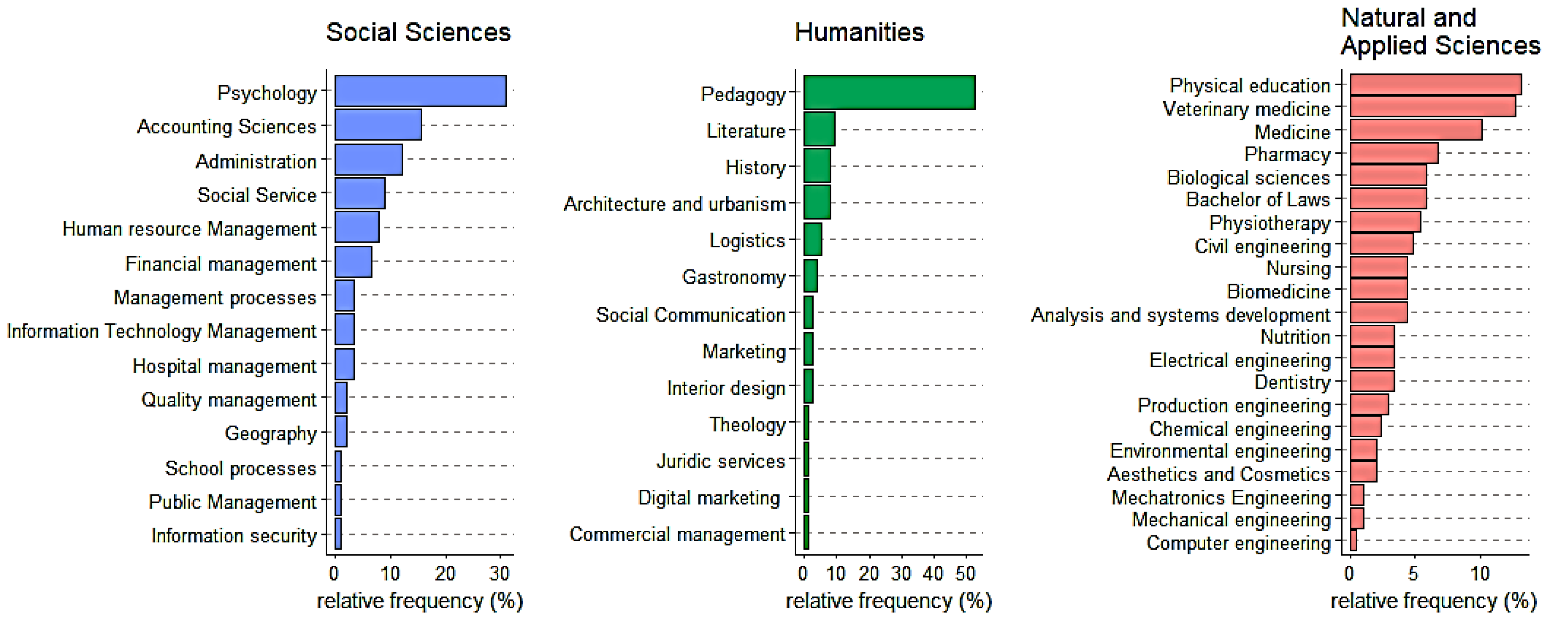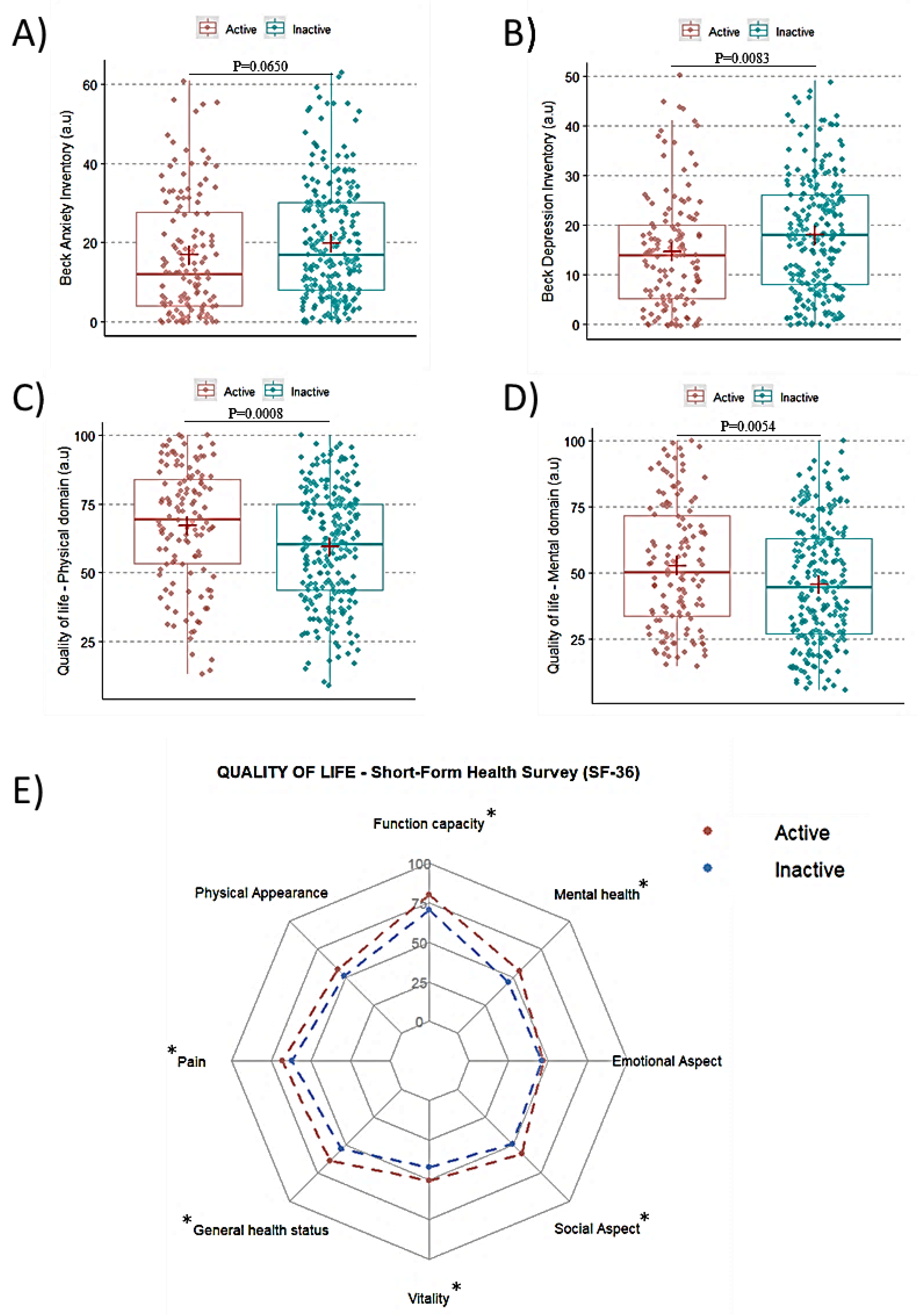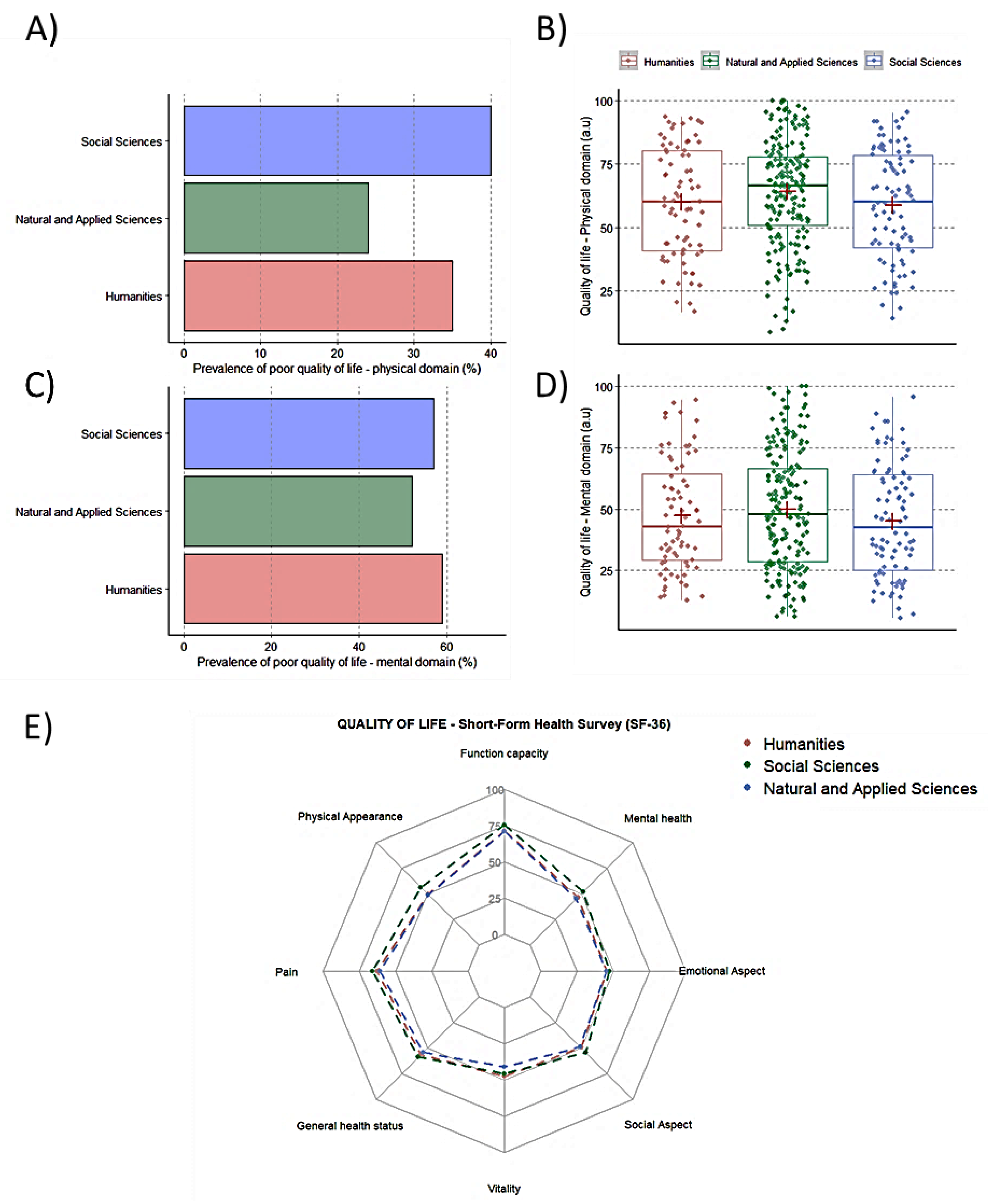Physically Inactive Undergraduate Students Exhibit More Symptoms of Anxiety, Depression, and Poor Quality of Life than Physically Active Students
Abstract
1. Introduction
2. Materials and Methods
2.1. Study Design and Participants
2.2. International Physical Activity Questionnaire
2.3. Anxiety and Depression Symptoms Assessment
2.4. Health-Related Quality of Life
2.5. Statistical Analyses
3. Results
4. Discussion
5. Conclusions
Author Contributions
Funding
Institutional Review Board Statement
Informed Consent Statement
Data Availability Statement
Conflicts of Interest
References
- Pavicic Zezelj, S.; Cvijanovic Peloza, O.; Mika, F.; Stamenkovic, S.; Mahmutovic Vranic, S.; Sabanagic Hajric, S. Anxiety and depression symptoms among gas and oil industry workers. Occup. Med. 2019, 69, 22–27. [Google Scholar] [CrossRef] [PubMed]
- GBD 2019 Mental Disorders Collaborators. Global, regional, and national burden of 12 mental disorders in 204 countries and territories, 1990–2019: A systematic analysis for the Global Burden of Disease Study 2019. Lancet Psychiatry 2022, 9, 137–150. [Google Scholar] [CrossRef] [PubMed]
- Dahlin, M.; Joneborg, N.; Runeson, B. Stress and depression among medical students: A cross-sectional study. Med. Educ. 2005, 39, 594–604. [Google Scholar] [CrossRef] [PubMed]
- Sreeramareddy, C.T.; Shankar, P.R.; Binu, V.S.; Mukhopadhyay, C.; Ray, B.; Menezes, R.G. Psychological morbidity, sources of stress and coping strategies among undergraduate medical students of Nepal. BMC Med. Educ. 2007, 7, 26. [Google Scholar] [CrossRef] [PubMed]
- Bull, F.C.; Al-Ansari, S.S.; Biddle, S.; Borodulin, K.; Buman, M.P.; Cardon, G.; Carty, C.; Chaput, J.P.; Chastin, S.; Chou, R.; et al. World Health Organization 2020 guidelines on physical activity and sedentary behaviour. Br. J. Sports Med. 2020, 54, 1451–1462. [Google Scholar] [CrossRef] [PubMed]
- Werneck, A.O.; Stubbs, B.; Fernandes, R.A.; Szwarcwald, C.L.; Silva, D.R. Leisure time physical activity reduces the association between TV-viewing and depressive symptoms: A large study among 59,401 Brazilian adults. J. Affect. Disord. 2019, 252, 310–314. [Google Scholar] [CrossRef]
- Stubbs, B.; Koyanagi, A.; Hallgren, M.; Firth, J.; Richards, J.; Schuch, F.; Rosenbaum, S.; Mugisha, J.; Veronese, N.; Lahti, J.; et al. Physical activity and anxiety: A perspective from the World Health Survey. J. Affect. Disord. 2017, 208, 545–552. [Google Scholar] [CrossRef]
- Guthold, R.; Stevens, G.A.; Riley, L.M.; Bull, F.C. Worldwide trends in insufficient physical activity from 2001 to 2016: A pooled analysis of 358 population-based surveys with 1.9 million participants. Lancet Glob. Health 2018, 6, e1077–e1086. [Google Scholar] [CrossRef]
- de Souza, K.C.; Mendes, T.B.; Gomes, T.H.S.; da Silva, A.A.; Nali, L.; Bachi, A.L.L.; Rossi, F.E.; Gil, S.; Franca, C.N.; Neves, L.M. Medical Students Show Lower Physical Activity Levels and Higher Anxiety Than Physical Education Students: A Cross-Sectional Study During the COVID-19 Pandemic. Front. Psychiatry 2021, 12, 804967. [Google Scholar] [CrossRef]
- Castro, O.; Bennie, J.; Vergeer, I.; Bosselut, G.; Biddle, S.J.H. How Sedentary Are University Students? A Systematic Review and Meta-Analysis. Prev. Sci. 2020, 21, 332–343. [Google Scholar] [CrossRef]
- Kljajevic, V.; Stankovic, M.; Dordevic, D.; Trkulja-Petkovic, D.; Jovanovic, R.; Plazibat, K.; Orsolic, M.; Curic, M.; Sporis, G. Physical Activity and Physical Fitness among University Students-A Systematic Review. Int. J. Environ. Res. Public Health 2021, 19, 158. [Google Scholar] [CrossRef] [PubMed]
- Shimamoto, H.; Suwa, M.; Mizuno, K. Relationships between Depression, Daily Physical Activity, Physical Fitness, and Daytime Sleepiness among Japanese University Students. Int. J. Environ. Res. Public Health 2021, 18, 8036. [Google Scholar] [CrossRef] [PubMed]
- Nelson, M.C.; Taylor, K.; Vella, C.A. Comparison of Self-Reported and Objectively Measured Sedentary Behavior and Physical Activity in Undergraduate Students. Meas. Phys. Educ. Exerc. Sci. 2019, 23, 237–248. [Google Scholar] [CrossRef] [PubMed]
- Edelmann, D.; Pfirrmann, D.; Heller, S.; Dietz, P.; Reichel, J.L.; Werner, A.M.; Schafer, M.; Tibubos, A.N.; Deci, N.; Letzel, S.; et al. Physical Activity and Sedentary Behavior in University Students-The Role of Gender, Age, Field of Study, Targeted Degree, and Study Semester. Front. Public Health 2022, 10, 821703. [Google Scholar] [CrossRef]
- Irena, K.; Anna, M.; Anda, B. Physical activity and its relation to health-related physical fitness in students. Ovidius Univ. Ann. Ser. Phys. Educ. Sport/Sci. Mov. Health 2012, 12, 227–233. [Google Scholar]
- Craig, C.L.; Marshall, A.L.; Sjostrom, M.; Bauman, A.E.; Booth, M.L.; Ainsworth, B.E.; Pratt, M.; Ekelund, U.; Yngve, A.; Sallis, J.F.; et al. International physical activity questionnaire: 12-country reliability and validity. Med. Sci. Sports Exerc. 2003, 35, 1381–1395. [Google Scholar] [CrossRef]
- Beck, A.T.; Epstein, N.; Brown, G.; Steer, R.A. An inventory for measuring clinical anxiety: Psychometric properties. J. Consult. Clin. Psychol. 1988, 56, 893. [Google Scholar] [CrossRef]
- Beck, A.T.; Ward, C.; Mendelson, M.; Mock, J.; Erbaugh, J. Beck depression inventory (BDI). Arch. Gen. Psychiatry 1961, 4, 561–571. [Google Scholar] [CrossRef]
- Brazier, J.E.; Harper, R.; Jones, N.M.; O’Cathain, A.; Thomas, K.J.; Usherwood, T.; Westlake, L. Validating the SF-36 health survey questionnaire: New outcome measure for primary care. BMJ 1992, 305, 160–164. [Google Scholar] [CrossRef]
- Ware, J.E., Jr. SF-36 health survey update. Spine (Phila Pa 1976) 2000, 25, 3130–3139. [Google Scholar] [CrossRef]
- Ware, J.E., Jr.; Sherbourne, C.D. The MOS 36-item short-form health survey (SF-36): I. Conceptual framework and item selection. Med. Care 1992, 30, 473–483. [Google Scholar] [CrossRef] [PubMed]
- Schuch, F.B.; Vancampfort, D.; Firth, J.; Rosenbaum, S.; Ward, P.B.; Silva, E.S.; Hallgren, M.; Ponce De Leon, A.; Dunn, A.L.; Deslandes, A.C.; et al. Physical Activity and Incident Depression: A Meta-Analysis of Prospective Cohort Studies. Am. J. Psychiatry 2018, 175, 631–648. [Google Scholar] [CrossRef] [PubMed]
- Pearce, M.; Garcia, L.; Abbas, A.; Strain, T.; Schuch, F.B.; Golubic, R.; Kelly, P.; Khan, S.; Utukuri, M.; Laird, Y.; et al. Association Between Physical Activity and Risk of Depression: A Systematic Review and Meta-analysis. JAMA Psychiatry 2022, 79, 550–559. [Google Scholar] [CrossRef] [PubMed]
- Brawner, C.A.; Churilla, J.R.; Keteyian, S.J. Prevalence of Physical Activity Is Lower among Individuals with Chronic Disease. Med. Sci. Sports Exerc. 2016, 48, 1062–1067. [Google Scholar] [CrossRef] [PubMed]
- Gamage, A.U.; Seneviratne, R.A. Physical inactivity, and its association with hypertension among employees in the district of Colombo. BMC Public Health 2021, 21, 2186. [Google Scholar] [CrossRef] [PubMed]
- Hamburg, N.M.; McMackin, C.J.; Huang, A.L.; Shenouda, S.M.; Widlansky, M.E.; Schulz, E.; Gokce, N.; Ruderman, N.B.; Keaney, J.F., Jr.; Vita, J.A. Physical inactivity rapidly induces insulin resistance and microvascular dysfunction in healthy volunteers. Arter. Thromb. Vasc. Biol. 2007, 27, 2650–2656. [Google Scholar] [CrossRef]
- Lee, I.M.; Shiroma, E.J.; Lobelo, F.; Puska, P.; Blair, S.N.; Katzmarzyk, P.T.; Lancet Physical Activity Series Working Group. Effect of physical inactivity on major non-communicable diseases worldwide: An analysis of burden of disease and life expectancy. Lancet 2012, 380, 219–229. [Google Scholar] [CrossRef]
- Sarkin, J.A.; Nichols, J.F.; Sallis, J.F.; Calfas, K.J. Self-report measures and scoring protocols affect prevalence estimates of meeting physical activity guidelines. Med. Sci. Sports Exerc. 2000, 32, 149–156. [Google Scholar] [CrossRef]
- Stock, C.; Wille, L.; Kramer, A. Gender-specific health behaviors of German university students predict the interest in campus health promotion. Health Promot. Int. 2001, 16, 145–154. [Google Scholar] [CrossRef]
- Steptoe, A.; Wardle, J.; Pollard, T.M.; Canaan, L.; Davies, G.J. Stress, social support and health-related behavior: A study of smoking, alcohol consumption and physical exercise. J. Psychosom. Res. 1996, 41, 171–180. [Google Scholar] [CrossRef]
- Schlarb, A.A.; Kulessa, D.; Gulewitsch, M.D. Sleep characteristics, sleep problems, and associations of self-efficacy among German university students. Nat. Sci. Sleep 2012, 4, 1–7. [Google Scholar] [CrossRef] [PubMed]
- Nadorff, M.R.; Nazem, S.; Fiske, A. Insomnia symptoms, nightmares, and suicidal ideation in a college student sample. Sleep 2011, 34, 93–98. [Google Scholar] [CrossRef] [PubMed]
- Grasdalsmoen, M.; Eriksen, H.R.; Lonning, K.J.; Sivertsen, B. Physical exercise and body-mass index in young adults: A national survey of Norwegian university students. BMC Public Health 2019, 19, 1354. [Google Scholar] [CrossRef]
- Korn, L.; Gonen, E.; Shaked, Y.; Golan, M. Health perceptions, self and body image, physical activity and nutrition among undergraduate students in Israel. PLoS ONE 2013, 8, e58543. [Google Scholar] [CrossRef]
- Rodríguez-Romo, G.; Acebes-Sánchez, J.; García-Merino, S.; Garrido-Muñoz, M.; Blanco-García, C.; Diez-Vega, I. Physical Activity and Mental Health in Undergraduate Students. Int. J. Environ. Res. Public Health 2023, 20, 195. [Google Scholar] [CrossRef] [PubMed]
- Schuch, F.B.; Stubbs, B.; Meyer, J.; Heissel, A.; Zech, P.; Vancampfort, D.; Rosenbaum, S.; Deenik, J.; Firth, J.; Ward, P.B.; et al. Physical activity protects from incident anxiety: A meta-analysis of prospective cohort studies. Depress. Anxiety 2019, 36, 846–858. [Google Scholar] [CrossRef] [PubMed]
- Kandola, A.; Ashdown-Franks, G.; Hendrikse, J.; Sabiston, C.M.; Stubbs, B. Physical activity and depression: Towards understanding the antidepressant mechanisms of physical activity. Neurosci. Biobehav. Rev. 2019, 107, 525–539. [Google Scholar] [CrossRef]
- Brown, M.W.; Aggleton, J.P. Recognition memory: What are the roles of the perirhinal cortex and hippocampus? Nat. Rev. Neurosci. 2001, 2, 51–61. [Google Scholar] [CrossRef]
- Hartley, T.; Bird, C.M.; Chan, D.; Cipolotti, L.; Husain, M.; Vargha-Khadem, F.; Burgess, N. The hippocampus is required for short-term topographical memory in humans. Hippocampus 2007, 17, 34–48. [Google Scholar] [CrossRef]
- Brumariu, L.E.; Waslin, S.M.; Gastelle, M.; Kochendorfer, L.B.; Kerns, K.A. Anxiety, academic achievement, and academic self-concept: Meta-analytic syntheses of their relations across developmental periods. Dev. Psychopathol. 2022, 1–17. [Google Scholar] [CrossRef]
- Voltas, N.; Hernandez-Martinez, C.; Aparicio, E.; Arija, V.; Canals, J. Psychopathological factors that can influence academic achievement in early adolescence: A three-year prospective study. Span. J. Psychol. 2014, 17, E100. [Google Scholar] [CrossRef] [PubMed]
- INEP Censo da Educação Superior. Available online: https://www.gov.br/inep/pt-br/areas-de-atuacao/pesquisas-estatisticas-e-indicadores/censo-da-educacao-superior/resultados (accessed on 5 January 2023).




| Outcomes | n = 371 |
|---|---|
| Age, years | 31 ± 9 |
| Sex, n (%) | |
| Female | 287 (77%) |
| Male | 84 (23%) |
| Ethnicity, n (%) | |
| White | 56 (15%) |
| Black | 189 (51%) |
| Asian | 116 (31%) |
| Pardo a | 10 (3%) |
| Smoking status, n (%) | |
| Never | 33 (9%) |
| Current | 39 (10%) |
| Former smoker | 299 (81%) |
| Comorbidities, n (%) | |
| Asthma | 8 (2%) |
| Systemic arterial hypertension | 22 (6%) |
| Depression | 48 (13%) |
| Dyslipidemia | 9 (2%) |
| Obesity (IMC ≥ 30 kg/m2) | 72 (19%) |
| Type 2 diabetes | 7 (2%) |
Disclaimer/Publisher’s Note: The statements, opinions and data contained in all publications are solely those of the individual author(s) and contributor(s) and not of MDPI and/or the editor(s). MDPI and/or the editor(s) disclaim responsibility for any injury to people or property resulting from any ideas, methods, instructions or products referred to in the content. |
© 2023 by the authors. Licensee MDPI, Basel, Switzerland. This article is an open access article distributed under the terms and conditions of the Creative Commons Attribution (CC BY) license (https://creativecommons.org/licenses/by/4.0/).
Share and Cite
Santana, E.E.S.d.; Neves, L.M.; Souza, K.C.d.; Mendes, T.B.; Rossi, F.E.; Silva, A.A.d.; Oliveira, R.d.; Perilhão, M.S.; Roschel, H.; Gil, S. Physically Inactive Undergraduate Students Exhibit More Symptoms of Anxiety, Depression, and Poor Quality of Life than Physically Active Students. Int. J. Environ. Res. Public Health 2023, 20, 4494. https://doi.org/10.3390/ijerph20054494
Santana EESd, Neves LM, Souza KCd, Mendes TB, Rossi FE, Silva AAd, Oliveira Rd, Perilhão MS, Roschel H, Gil S. Physically Inactive Undergraduate Students Exhibit More Symptoms of Anxiety, Depression, and Poor Quality of Life than Physically Active Students. International Journal of Environmental Research and Public Health. 2023; 20(5):4494. https://doi.org/10.3390/ijerph20054494
Chicago/Turabian StyleSantana, Endrew Eduardo Santos de, Lucas Melo Neves, Karla Cardoso de Souza, Tassia Barcelos Mendes, Fabricio Eduardo Rossi, Ariana Aline da Silva, Rosemeire de Oliveira, Mauro Sergio Perilhão, Hamilton Roschel, and Saulo Gil. 2023. "Physically Inactive Undergraduate Students Exhibit More Symptoms of Anxiety, Depression, and Poor Quality of Life than Physically Active Students" International Journal of Environmental Research and Public Health 20, no. 5: 4494. https://doi.org/10.3390/ijerph20054494
APA StyleSantana, E. E. S. d., Neves, L. M., Souza, K. C. d., Mendes, T. B., Rossi, F. E., Silva, A. A. d., Oliveira, R. d., Perilhão, M. S., Roschel, H., & Gil, S. (2023). Physically Inactive Undergraduate Students Exhibit More Symptoms of Anxiety, Depression, and Poor Quality of Life than Physically Active Students. International Journal of Environmental Research and Public Health, 20(5), 4494. https://doi.org/10.3390/ijerph20054494









